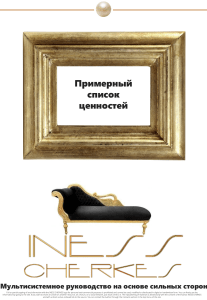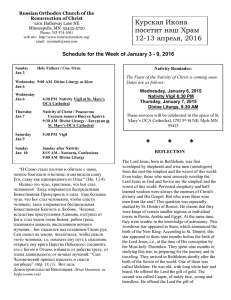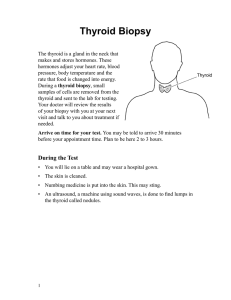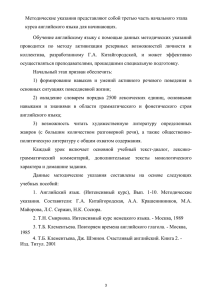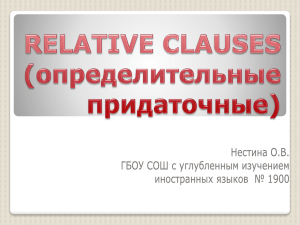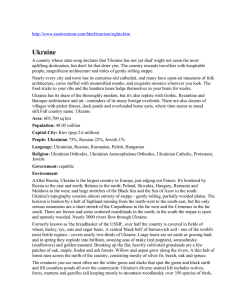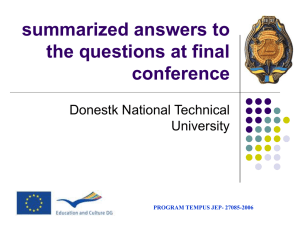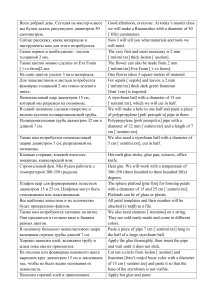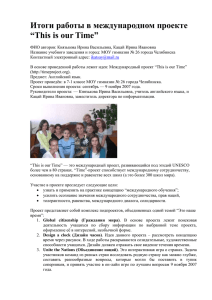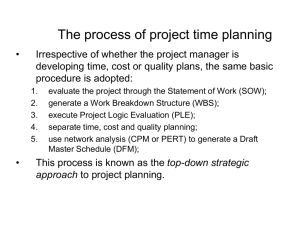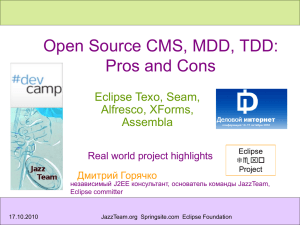Проект реконцепции Парка Горького
advertisement

28 актуально hot topic Текст: Валерия Семенова Фото: архив CRE Немного сахара… для парка Горького В конце июля врио мэра Москвы Сергей Собянин объявил о создании самого крупного парка в Европе, в который войдут территории парка Музеон, ЦПКиО имени Горького, Нескучного сада и природного заказника «Воробьевы горы». Что получится из этой затеи? Каким будет это общественное пространство? И кто будет участвовать в проекте? «С прогулок для москвичей и гостей города. В июле стало известно егодня мы наблюдаем очевид- о создании самого крупного парка в Европе, в который помимо ные шаги к тому, чтобы город из совокуп- ЦПКиО им. Горького войдут Музеон, Нескучный сад и природный ности зданий и сооружений превращался заказник «Воробьевы горы». в среду обитания: районы исторического «Разработчик концепции этого проекта – LDA Design – был центра (Сретенка, Замоскворечье) избавля- выбран на международном конкурсе. Таким образом, была про- ются от неоднородных вывесок, упрощается должена практика ряда знаковых проектов (“Сколково”, Новая навигация отдельных участков, благоустраи- Москва, Зарядье), – рассказывает Алексей Поляков, генеральный ваются территории. Очень позитивное директор «Просперити Проджект Менеджмент», председатель начинание – создание пешеходной зоны правления совета по экологическому строительству в России. – на Кузнецком мосту», – отмечает Светлана LDA Design для работы над концепцией парка Горького создала Ярова, начальник отдела стрит-ритейла ком- команду из урбанистов, ландшафтных дизайнеров, экспертов куль- пании Jones Lang LaSalle. Но эталонный при- турного наследия и управления парками. Характеристиками эко- мер создания общественного пространства – логического строительства проекта являются значительная роль парк Горького, который за последние годы ландшафтного дизайна, транспортная доступность (общественный стал едва ли не самым популярным местом транспорт, велосипед), сохранение культурного и исторического C o m m e r c i a l R e a l E s t a te # 16 (214) 29 наследия, инклюзивность (для всех возрастных и социальных групп), восстановление нескольких исторических зданий и ландшафтов, объединение в единое зеленое пространство Воробьевых гор, Нескучного сада и парка Горького». Каким будет новый проект? Основных идей три. Во‑первых, будет сделан акцент на исторических постройках Нескучного сада – усадьбы Орлова, Голицына и Трубецкого. Во‑вторых, будут созданы новые центры рекреационной активности по внутренней границе парковой территории: сады отдыха, семейный центр, пространство живописи (совместно с ЦСИ «Гараж»), оранжерея, вишневый сад, физкультурно-игровой центр и проч. Таким образом, авторы концепции хотят привлечь в парк значительно более широкую аудиторию, чем существующая сегодня. И, в‑третьих, меняются границы парка. Создаются новые входы (к уже существующим добавятся еще четыре), реорганизуются старые: это должно помочь распределить потоки посетителей, в первую очередь автомобилистов, чтобы избежать концентрации припаркованных Согласно концепции LDA Architects, все зоны автомобилей на одной площадке. Собственно, в этом и состоит обновленного парка будут связаны кольце- основное решение парковочной проблемы, предлагаемое автора- вым маршрутом, проходящим через центры ми концепции. активности. Количество используемых лужаек С одной стороны, позиция объяснима: парк рассчитан прежде увеличится на 300 %, количество асфальта всего на москвичей, которые пользуются городским транспортом. сократится на 30 %, построек станет меньше Поэтому почти демонстративное пренебрежение к расширению на 50 %. Как ни парадоксально, думая о новой парковочного пространства вполне оправданно. С другой – воз- концепции парка, ее авторы исходили из того, можное неконтролируемое увеличение транспортных потоков все- что сейчас в парке слишком высокая кон- таки выглядит уязвимым местом проекта. центрация мероприятий, и это не дает людям 30 актуально hot topic расслабиться. Поэтому, хоть и планируется регулярно проводить в парке различные мероприятия, делаться это будет дозированно, точки активности распределятся по парку болееменее равномерно. «Крайне интересно, как будет выглядеть в реализованном виде идея о проведении культурных мероприятий на территории парка, – отмечает Анна Нистратова, культурный куратор дизайн-завода «Флакон». – Для успеха проекта важно, чтобы арт-составляющая была доста- Работа над общественными зонами – всегда интересно, особенно над данным проектом. Для Нескучного сада и Партера оформление территории происходит в очень разных исторических периодах. Таким образом, парк представлет собой некую энциклопедию по оформлению территории, и в нашей концепЭндрю Харланд, ции потребовалось проявить старший партнер к этому уважение, добавляя компании LDA Design при этом новые современные детали дизайна для сегодняшнего использования посетителями территории проекта. Когда парки долго страдают от отсутствия согласованных восприятия и пути развития, часто их проблемы довольно типичны. Однако это не означает, что решение таких проблем очень просто: у многочисленных групп интересов есть различные приоритеты и заинтересованность в общественных пространствах, что, соответственно, делает стратегию довольно сложной. Наличие разных собственников, управляющие авторитеты, договоренности по лизингу и назначения земли по соседству могут делать ее и еще сложнее. Планируется, что физические работы по реставрации будут осуществлены в достаточно краткие сроки, поэтому одна из главных задач, с точки зрения реализации концепции, будет заключаться именно в том, чтобы получить скоординированное, качественное решение по дизайну и затем контролировать качество работ над зданием и территорией. Самые интересные и необычные решения в проекте – это, наверное, предложения для зимних садов на набережной и новый детский центр «Сердце парка», который находится на пересечении Партера и Нескучного сада. В настоящее время обе эти территории остаются невостребованными большую часть года, и предложения на этих территориях создали бы две совершенно новые части парка, что способстовало бы концепции «Культура навстречу природе». точно выраженной. Хорошо, если в результате современное искусство – в том числе уличное – отмечает Мария Белякова, психолог, эксперт маркетинговых кампа- получит площадку именно здесь. Пока город ний агентства Digital Boutique, основные потребности, возникающие предоставляет немного возможностей такого у отдыхающих в городской черте людей, – это потребность в восста- рода». новлении энергии, получении эстетического удовольствия, общении; «Несомненным плюсом концепции является рациональные и познавательные потребности; возможность выбора уменьшение количества построек и асфаль- досуга в соответствии со своими предпочтениями. «Данная концепция тового покрытия в парке, – считает Наталья благоустройства как раз предоставляет посетителям некий спектр Сидорова, партнер «Архитектурной группы развлечений, в котором они смогут выбрать то, что им действительно ДНК». – Отдельного внимания, на мой взгляд, по душе», – отмечает Мария Белякова. требует набережная в рамках парка Горького По словам Андрея Перегудова, старшего вице-президента и непосредственно прилегающая к ней терри- ОАО«Банк ВТБ», генерального директора УК «Динамо», парки снова тория в парке. Этот вопрос необходимо рас- становятся частью повседневной жизни горожан. «В 90‑е годы в горо- сматривать в увязке с концепцией планируемой де сформировалась атмосфера, связанная с введением свободной единой пешеходной набережной Воробьевы экономики, новыми возможностями, но и с существенным стрессом. горы–Болотная». Парки, которые всегда отражают жизнь города, утратили в тот момент И, наконец, один из центральных вопросов, функцию места притяжения, перестали быть местом безмятежного касающихся новой концепции, – это привле- отдыха. Сейчас эта функция наконец возвращается. Приятно уча- чение и удержание разновозрастных групп ствовать в этом процессе, занимаясь реконструкцией парка Динамо, граждан: такая задача была выделена авто- приятно видеть те значительные шаги в нужном направлении, которые рами проекта как одна из центральных. Как уже сделаны, и развитие парка Горького – из их числа». C o m m e r c i a l R e a l E s t a te # 16 (214) 31 Text: Valeria Semenova Photo: CRE archive A Bit of Sugar… for Gorky Park In late July, Sergey Sobyanin, the Acting Mayor of Moscow, announced the creation of the largest park in Europe, which will include the Muzeon Park, Gorky Park, Neskuchny Garden, the nature reserve Vorobyovy Gory (Sparrow Hills). What will come of this idea? What will this public space be like? Who will be involved in the project? “T oday we can witness the concrete measures that are being taken transport, bicycles), preservation of cultural and historical heritage, inclusiveness (for all ages and social groups), the restoration of several historic buildings and to ensure that the city is converting from a totality of buildings into a living landscapes, merging Vorobyovy Gory (Sparrow Hills), Neskuchny Garden and environment: the districts of the historical center – Sretenka, Zamoskvorechye are Gorky Park into a single ‘green space’.” getting rid of non-uniform signboards, navigation in individual areas is simplified, What will the new project be like? There are three main ideas. First, the empha- and the territories are landscaped.The creation of a pedestrian zone on Kuznetsky sis will be laid on the historic buildings of Neskuchny Garden – estates of Orlov, Most is a very positive initiative,” says Svetlana Yarova, head of street retail at Golitsyn and Trubetskoy. Second, there will be created new recreational centers Jones Lang LaSalle. However, the model example of creating a public space is within the inner boundary of the park area, such as recreation gardens, a family Gorky Park, which has recently become the most popular walking place for center, space for painting (with CSI Garage), a greenhouse, a cherry orchard, Muscovites and guests of the city. It was reported in July about the creation of the sports and game centers, etc. Thus, the authors of the concept want to bring to largest parks in Europe, which in addition to Gorky Park, will also include Muzeon the park a much wider audience than it has today. And third, the boundaries of Park, Neskuchny Garden, the nature reserve Vorobyovy Gory. the park will be changed. New entrances will be created (4 more will be added to “LDA Design, developer of this concept, was selected through an interna- the existing ones) and the old ones will be reorganized – this should help spread tional contest. Thus, the practice of several landmark projects (Skolkovo, ‘New the flow of visitors, first of all, motorists to avoid the concentration of parked cars Moscow’, Zaryadye) was continued,” says Alexey Polyakov, general director of on one site. Actually, this is the main solution to the parking problem, offered by Prosperity Project Management and chairman of the board of Green Building the authors of the concept. Council in Russia. “LDA Design has created a team of urban planners, landscape On the one hand, the position is understandable: the park is primarily designed architects, experts and cultural heritage and park managers to carry out work for Muscovites who use public transport. Therefore, this virtually pointed disre- on the concept of Gorky Park. Ecological construction can be characterized by gard for the expansion of parking space is justified. On the other hand, the pos- a significant part of landscape design, transport accessibility of the park (public sible uncontrolled increase in traffic looks like a vulnerable point of the project. 32 актуально hot topic with the concept of the planned unified pedestrian promenade Vorobyovy Andrew Harland, senior partner at LDA Design: Gory – Bolotnaya.” Working on public parks is always interesting, and especially this one. Both the Neskuchny Gardens and The Parterre’s landscape design originated from diverse periods of Russia’s history. In effect, the park is like an encyclopedia of landscape design, and our concept needed to respect that, yet also add a new layer of design for today’s usage and visitors. When parks have suffered from a lack of a coordinated vision and direction for a long time, the problems are usually fairly typical. This does not however mean that solving such problems is easy; lots of different interest groups have different priorities and vested interests in a public park, which therefore makes the strategy fairly complicated. Having different owners, managing authorities, lease arrangements and neighboring land uses can make it even more complicated. The physical restoration works are planned to be carried out in a relatively short timescale, therefore achieving a coordinated high quality design solution and then controlling the quality of the building and landscape works will be one of the main challenges in realizing the concept. The best features would be the proposals for the Winter gardens on the embankment, and the new ‘Heart of the Park’ children’s center – located where the Parterre meets Neskuchny Gardens. At present, both these areas are really underused for much of the year, and new proposals for these areas would create two totally new parts of the park, which would contribute to the overall vision of ‘Culture meeting Nature’. attraction and retention of people of different age groups: this problem And finally, one of the central issues concerning the new concept is the was highlighted by the authors of the project as one of the central ones. As noted by Maria Belyakova, psychologist, expert in marketing campaigns of Digital Boutique Agency, the basic needs of people vacationing in the city, include restoration of energy and obtaining aesthetic pleasure, communication, rational and cognitive needs, as well as the possibility to choose leisure in accordance with their preferences. “The concept of improvement provides visitors with a range of activities, from which they can choose what they really like,”said Maria Belyakova. According to Andrey Peregudov, Senior Vice President of VTB Bank, General Manager of the UK Dynamo, the parks again are becoming a part of the daily life of citizens. “In the 1990s, a special atmosphere was formed in the city, associated with the introduction of the free economy, with new opportunities, but also with significant stress. Parks, which always reflect the life of the city, lost, at that moment, their function of being places of attraction; they ceased to be a place of serene relaxation. Now this feature is finally back – it is a pleasure to participate in this process, engaging in the reconstruction of Dynamo Park, and it is pleasant to see the significant steps in the right direction, which have already been made, the development of Gorky Park being one of them.” According to the concept of LDA Architects, You would be surprised, but according to statistics, Moscow is one of the all the areas of the renovated park will be con- greenest cities in the world. It does not sound very plausible, given that in nected by a ring route, running through the activity the last decade, we have seen how actively the roads have been expanded, centers. The number of lawns will increase by and therefore the amount of green space along them visibly diminished. 300%, the amount of asphalt will be reduced by There are fewer trees in the streets, new buildings are erected without 30%, and the number of buildings will be reduced landscaping of the area around them, funds for landscape design in the by 50%. Paradoxically, thinking about the new construction of new facilities are allocated on a residual basis, and so new concept of the park, its authors proceeded from buildings tend to remain without greenery. And we get used to this picture the fact that too many events are happening in the – buildings are erected and there are no “green spots” around them, just park now and it does not allow people to relax. asphalt and houses, concrete and glass… Therefore, although various activities are planned Fortunately, despite this, we still have hundreds of acres of virtually to be held in the park on a regular basis, this will untouched forests within the city, and these are such large green areas as be done proportionally, and the points of activity Sokolniki, Izmailovo, Bittsevsky Park, and Neskuchny Garden. will be more or less evenly distributed. “It is interesting to see how the idea of conduct- We can and should support the urban initiative to revive life in the parks. It is nice to see how parks again are becoming part of the daily life of ing cultural activities in the park will be imple- citizens. In 1990s, a very special atmosphere was formed in the city. It was mented in practice,” said Anna Nistratova, associated with free economy, the emergence of economic and financial cultural curator of the design plant Flakon. “The relations, new possibilities, but also with stress and anxiety. During this success of the project requires a sufficiently period, a lot of new people came to Moscow, charged with the spirit of expressed cultural component. It will be good if “free enterprise”. All this gave the feeling that the city ceased to belong contemporary art, including street art, will get a to its inhabitants. Parks always reflect the life in the city, they are a kind of platform here. So far, the city provides few op- “mirror”– and in the 1990s, performing this role, they lost their function of portunities of this kind.” being a place of attraction, and they ceased to be the territory of health, “An undeniable advantage of the concept is the reduction in the number of buildings and asphaltcoverage in the park,” said Natalia Sidorova, part- well-being and relaxing holiday, where people can spend a weekend with their families. In keeping with the spirit of its time, wholesale trade was present in our ner of the DNA Architectural Group. “In my opin- park – a flea market was situated on the main alley. The same thing hap- ion, special attention should be paid to Gorky Park pened at the Luzhniki Stadium, and in Sokolniki. Parks became not just and the promenade area, directly adjacent to it. uncomfortable, but frankly speaking, unsafe areas, transformed in fact, into This issue should be considered in conjunction markets and territories for semi-criminal gatherings. C o m m e r c i a l R e a l E s t a te # 16 (214)
